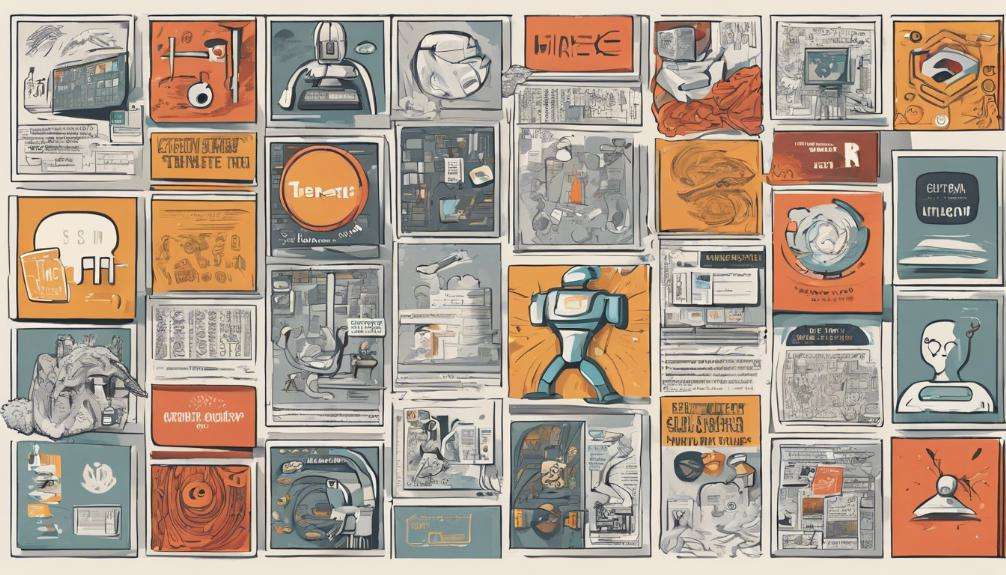Table of Contents
I recommend TensorFlow for image classification, PyTorch for flexibility, and Scikit-learn for user-friendly algorithms. These open-source AI tools provide solid foundations for various tasks and streamline model development. But the possibilities go beyond just these.
Main Talking Points
- TensorFlow and PyTorch are top open-source AI libraries for various tasks.
- SpaCy, NLTK, and Gensim offer powerful natural language processing tools.
- OpenCV, TensorFlow, and PyTorch are innovative frameworks for computer vision.
- Open-source robotics platforms enhance robots' capabilities and autonomy.
- Mozilla DeepSpeech and Kaldi provide advanced speech recognition solutions.
Top Machine Learning Libraries

When diving into the world of machine learning libraries, one quickly realizes the importance of selecting the top performers. Among the plethora of options available, TensorFlow stands out as one of the most popular choices. Its versatility and robustness make it a favorite among developers for tasks ranging from image classification to natural language processing. The ease of building and training neural networks with TensorFlow simplifies complex processes, allowing for efficient model development.
Another heavyweight contender in the field is PyTorch. Known for its dynamic computation graph, PyTorch offers flexibility and speed in model building. Its seamless integration with Python makes it a go-to option for researchers and practitioners alike. The ability to define, modify, and execute computational graphs on-the-fly sets PyTorch apart from other libraries.
Scikit-learn is another essential tool in the machine learning arsenal. Its user-friendly interface and extensive collection of algorithms make it ideal for beginners and experts alike. From classification to regression, clustering to dimensionality reduction, Scikit-learn provides a solid foundation for a wide array of machine learning tasks.
Powerful Natural Language Processing Tools
As we explore powerful natural language processing tools, the capabilities of these tools become increasingly evident in enhancing machine learning tasks. Tools like SpaCy, NLTK, and Gensim offer a wide range of functionalities that can preprocess text data, extract relevant information, and perform various linguistic analyses. These tools are instrumental in tasks such as sentiment analysis, named entity recognition, text classification, and more.
One of the key advantages of these natural language processing tools is their ability to handle unstructured data efficiently. They can parse through large volumes of text data, identify patterns, and derive meaningful insights. Additionally, these tools often come with pre-trained models that can be fine-tuned for specific tasks, saving time and resources in model development.
Furthermore, the integration of natural language processing tools with machine learning algorithms has led to significant advancements in areas such as chatbots, language translation, and text summarization. Leveraging these tools effectively can greatly enhance the performance and accuracy of machine learning models in various applications.
Innovative Computer Vision Frameworks

Exploring cutting-edge computer vision frameworks reveals the transformative impact they've on visual data analysis and pattern recognition tasks. These innovative frameworks leverage advanced algorithms to interpret and understand visual information, enabling machines to perceive and interpret the world much like humans.
One such framework is OpenCV, a versatile library that offers a wide range of tools for image processing, object detection, and even deep learning integration.
Another notable framework is TensorFlow, which provides a broad ecosystem for developing machine learning models, including those focused on computer vision tasks. Its flexibility and scalability make it a popular choice for researchers and developers working on complex visual recognition projects.
PyTorch is also gaining traction in the computer vision community due to its dynamic computational graph and intuitive interface, making it easier to experiment with different neural network architectures and optimize performance for vision-related tasks. These frameworks continue to push the boundaries of what's possible in computer vision, driving innovation and empowering developers to create groundbreaking applications.
Cutting-Edge Robotics Software
Exploring the world of cutting-edge robotics software reveals the exciting advancements driving the future of robotic technology. As a developer delving into this field, I'm amazed by the innovative software tools shaping the way robots perceive, interact, and navigate the world around them. One key aspect of cutting-edge robotics software is its ability to seamlessly integrate with advanced sensors, enabling robots to gather and process data in real-time with remarkable accuracy.
Moreover, the evolution of artificial intelligence and machine learning algorithms has revolutionized how robots learn from their environment and adapt to changing circumstances autonomously. This capability is vital for enhancing the efficiency and versatility of robotic systems across various industries, from manufacturing to healthcare.
Furthermore, the emergence of open-source robotics platforms has democratized access to sophisticated software frameworks, fostering collaboration and accelerating the pace of innovation in the field. By leveraging these tools, developers like myself can create intelligent and agile robots that push the boundaries of what was once thought possible. In essence, cutting-edge robotics software isn't just transforming the way we interact with machines; it's shaping a future where robots play a pivotal role in advancing human capabilities and improving our quality of life.
Advanced Speech Recognition Solutions

Venturing further into the domain of cutting-edge robotics software, the focus now shifts towards the sphere of Advanced Speech Recognition Solutions. Advanced speech recognition plays a pivotal role in enhancing human-robot interactions by enabling machines to comprehend and respond to spoken language with remarkable accuracy. These solutions leverage sophisticated algorithms and neural networks to decipher various accents, intonations, and languages, making communication more seamless and natural.
One notable open-source AI platform excelling in this arena is Mozilla DeepSpeech. Powered by deep learning technology, DeepSpeech offers state-of-the-art speech-to-text capabilities, allowing developers to integrate accurate speech recognition into their projects. Its flexible architecture and pre-trained models simplify the implementation process, making it a popular choice among AI enthusiasts and researchers.
Additionally, Kaldi, another prominent open-source toolkit, focuses on speech recognition for various languages and dialects. With its modular design and extensive documentation, Kaldi provides a robust framework for building customized speech recognition systems tailored to specific requirements. These advanced speech recognition solutions mark significant advancements in the field of AI, paving the way for more intuitive and interactive human-machine interfaces.
State-of-the-Art AI Chatbot Platforms
State-of-the-art AI chatbot platforms have revolutionized the way businesses engage with customers online. These platforms leverage cutting-edge artificial intelligence technologies to provide personalized and efficient customer support, lead generation, and sales assistance.
One of the leading platforms in this space is Google's Dialogflow, which offers a user-friendly interface for building conversational agents that can understand natural language and context.
Another prominent player is IBM's Watson Assistant, known for its advanced natural language processing capabilities and seamless integration with various business systems. Additionally, platforms like Microsoft Bot Framework and Amazon Lex enable developers to create sophisticated chatbots that can be deployed across multiple channels, including websites, messaging apps, and voice assistants.
These state-of-the-art AI chatbot platforms empower businesses to deliver round-the-clock customer service, improve operational efficiency, and drive customer engagement. By harnessing the power of AI, companies can enhance their online presence and stay ahead in today's competitive digital landscape.
Emerging AI Development Environments

Moving forward from the advancements in AI chatbot platforms, the focus now shifts to exploring the emerging AI development environments. As a developer, I find these new environments exciting and full of potential. One such environment gaining attention is Google's TensorFlow. TensorFlow provides a versatile platform for building and deploying machine learning models. Its flexibility and scalability make it a popular choice for both beginners and experts in the field.
Another emerging AI development environment worth mentioning is Microsoft's Azure Machine Learning Studio. This platform offers a user-friendly interface with drag-and-drop functionality, making it accessible to a wide range of users. Azure Machine Learning Studio also provides integration with popular programming languages like Python and R, enhancing its versatility.
Furthermore, IBM Watson Studio is making waves in the AI development community. With features like collaborative project management and data visualization tools, Watson Studio streamlines the development process. Its ability to deploy models to the cloud seamlessly adds to its appeal. Overall, these emerging AI development environments are shaping the future of AI innovation and empowering developers to create cutting-edge solutions.
Frequently Asked Questions
How Do Open Source AI Projects Ensure Data Privacy?
To guarantee data privacy, open source AI projects implement robust security measures, such as encryption protocols and access controls. They prioritize user consent and anonymization techniques to protect sensitive information.
Regular audits and compliance checks are conducted to maintain data integrity. By fostering transparency and community involvement, these projects build trust with users and stakeholders.
What Are the Common Challenges in Deploying AI Models?
Deploying AI models presents various challenges, such as guaranteeing compatibility with existing systems, managing large datasets efficiently, and addressing biases in the model.
It also involves selecting the right infrastructure and tools, dealing with model interpretability, and maintaining the model post-deployment.
Overcoming these obstacles requires careful planning, collaboration among teams, and continuous monitoring to guarantee the AI model performs effectively in real-world scenarios.
Are There Any Limitations to Using Open Source AI Tools?
There are limitations to using open source AI tools. While they offer cost-effective solutions, they may lack certain features or support compared to proprietary tools.
Security risks and potential compatibility issues can arise with open source AI tools. It's important to carefully evaluate the specific needs of a project before deciding on using open source tools to guarantee they align with the desired outcomes.
How Can Developers Contribute to Open Source AI Projects?
To contribute to open source AI projects, I engage with the community by reviewing existing issues and offering solutions through code contributions. By participating in discussions, sharing insights, and collaborating with other developers, I help enhance the project.
Regularly updating documentation, testing new features, and providing feedback also play a vital role in supporting the growth and improvement of open source AI initiatives.
What Are the Potential Ethical Implications of AI Development?
Potential ethical implications of AI development include biases in algorithms, invasion of privacy, and job displacement. We must address these issues to guarantee AI benefits society without harming individuals.
Transparency, diversity in development teams, and ethical guidelines are essential. As a developer, I aim to create AI systems that are fair, accountable, and transparent to mitigate these ethical concerns and promote responsible AI development.
Conclusion
Overall, the best open source AI tools offer a wide range of capabilities for developers to create innovative solutions. From machine learning libraries to robotics software, there are endless possibilities for advancing technology and improving efficiency.
With powerful natural language processing tools and state-of-the-art chatbot platforms, the future of AI development looks promising. I'm excited to see how these tools will continue to evolve and shape the world we live in.
